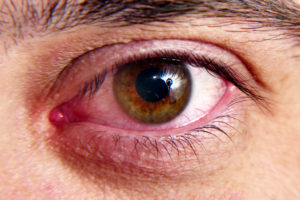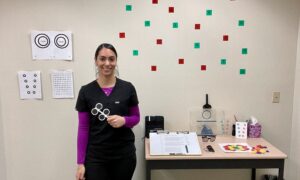By Laurie Sorrenson, OD, FAAO

July 12, 2023
You know how in optometry school they teach us to handle viral conjunctivitis with palliative remedies like lubricant drops and cool compresses because it is self-limiting? Well, I’ve got a slightly different take on that.
First of all, every doctor has had that patient with a seemingly innocent “red eye” that evolved into something more serious. I am also sure none of us has ever missed a single sign or symptom that could have pointed to a different diagnosis either! Ha-ha! That’s one of two reasons I believe in taking a proactive or aggressive approach when dealing with a “presumed” viral conjunctivitis.
At our office, we have a protocol for handling these “presumed” viral conjunctivitis patients. First, I flush the eye with a hypochlorous drop or spray (patients always say their eye feels better after that). Then, I’ll put in 2-3 drops of a steroid or a combo antibiotic/steroid that I keep in stock. I then prescribe a hypochlorous drop and either a combo antibiotic/steroid or just a steroid (if the cornea is completely clear). The dosage depends on severity of signs/symptoms, but it could be as frequent as one drop every hour for 24 hours, then every two hours for the next 24 hours, and then four times a day for a week.
Other Articles to Explore
We also make sure to check up on the patient the next day with a text from the doctor or one of our techs to make sure they’re feeling better. I have to say, 99 percent of the time they are feeling much better.
My second reason for being aggressive with a presumed viral conjunctivitis is all about practice management. This patient took time out of their busy life to make an appointment, drive all the way to our office, and go through the whole process of updating their information. Why? Because they want to look and feel better, and sometimes they’re even worried it could be something serious. I believe they want more than a lubricant drop, cool compress and an “It will go away on its own.”
With our protocol, this patient starts feeling better while they’re still sitting in the exam chair, thanks to that hypochlorous acid flush. By the time they reach the checkout, thanks to the steroid, they usually feel even better. After just 24 hours of using the steroid and HCL, they’re almost always feeling significantly better. That’s why they came to us in the first place, right? They want to feel better! And guess who they’re going to call when they need new glasses or contacts? I’m pretty confident that because we made their eye feel better so easily and quickly, their next appointment will be with us!
I believe that treating red eyes isn’t just about the medical side of things; it’s also a lesson in Practice Management 101.
 Laurie Sorrenson, OD, FAAO, is president of Lakeline Vision Source in Cedar Park, Texas, and the Professional Editor of Review of Optometric Business (ROB). To contact her: lsorrenson@gmail.com.
Laurie Sorrenson, OD, FAAO, is president of Lakeline Vision Source in Cedar Park, Texas, and the Professional Editor of Review of Optometric Business (ROB). To contact her: lsorrenson@gmail.com.



























